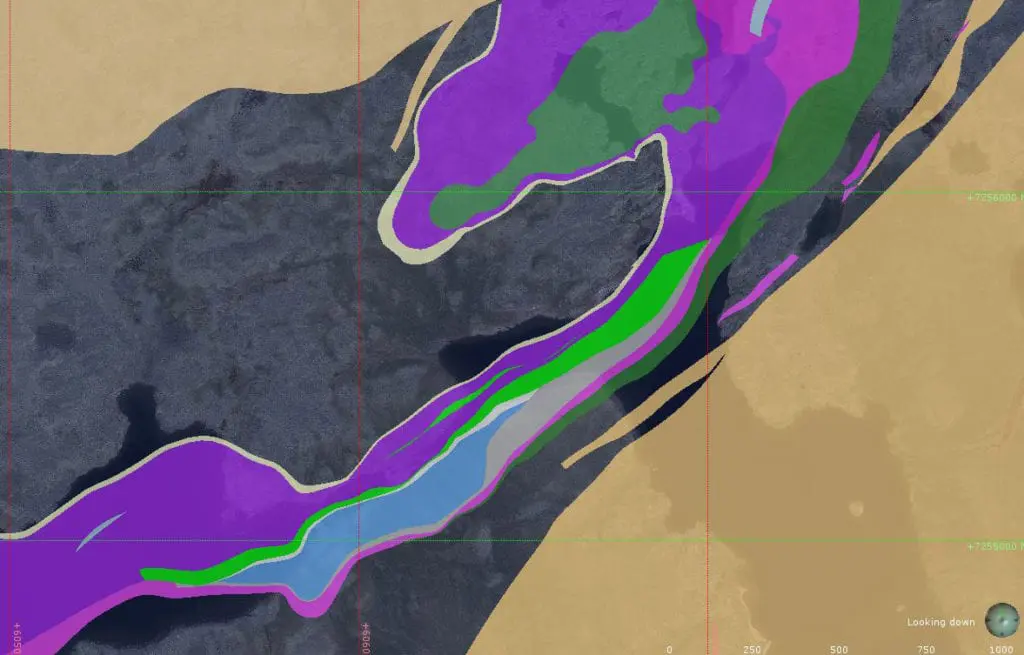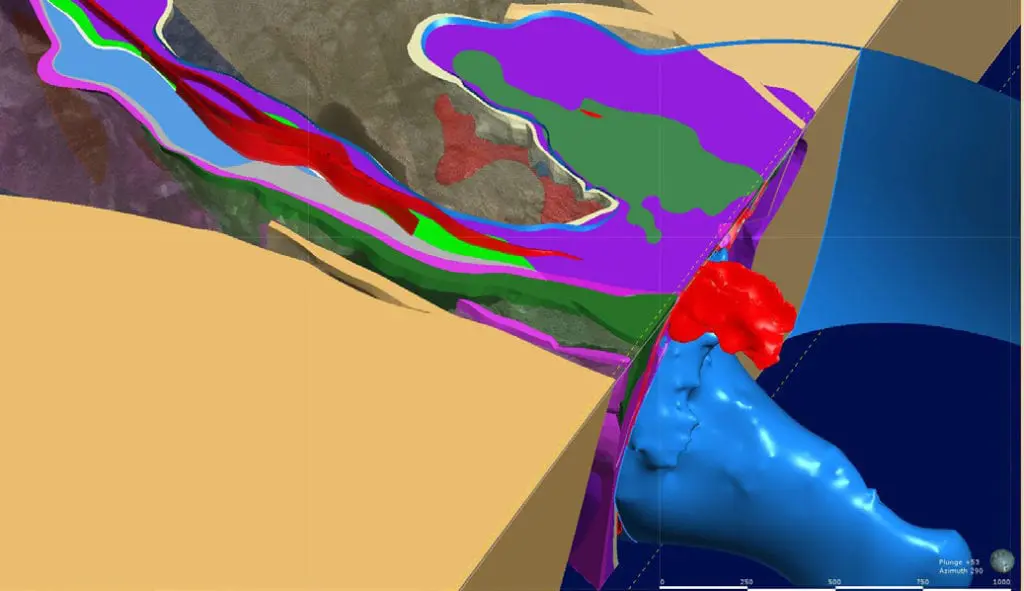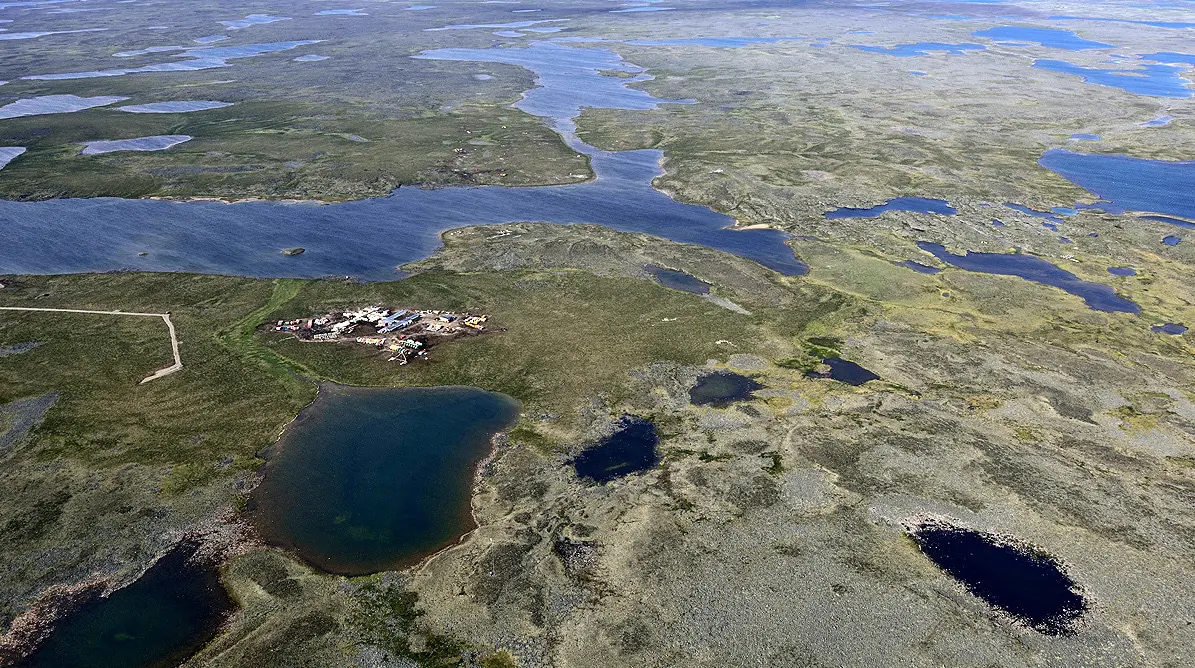The Amaruq project, located in Nunavut, Canada, was first discovered in 2013 by Agnico Eagle’s East Canada Exploration Team.
From the start of the project, the Exploration team used Leapfrog to understand the geological context; to plan and optimise drillhole campaigns; to communicate key project stages and to model mineralised wireframes used in resource estimation. Agnico Eagle first started using Leapfrog in 2012 and by the start of 2018 they had between 15-20 users.
Senior Geologist 3D modelling, Marjorie Simard, comments, “Amaruq has a complex geological context consisting of several deformation episodes and a lot of folding and faulting. We initially chose Leapfrog because it was easy to use and allowed us to readily display data from a complex dataset. But being able to update Leapfrog regularly with new information was critical to improving our understanding and to helping the team plan and optimise the drilling that ultimately led to the discovery.”
“Being able to update Leapfrog regularly with new information was critical to improve our understanding and help the team plan and optimise the drilling that ultimately led to the discovery.”
Marjorie Simard, Senior Geologist
3D Modelling, Technical Services, Agnico Eagle.
Geology
The Amaruq property covers 40 km of the Woodburn Lake Group of Archean supracrustal rocks, the same sequence as at Agnico-Eagle’s nearby Meadowbank mine. This is within the Rae domain of the Western Churchill geological province of the Canadian Shield. These rocks were possibly deposited in a continental rift setting and consist of mafic to ultramafic volcanics interlayered with carbon-rich sedimentary rocks. The rock sequence has since been intruded by granitoid rocks and common lamprophyres and affected by multiple phases of ductile deformation along with metamorphism to greenschist facies and locally to the upper greenschist facies.
Mineralisation
Six zones of gold-bearing quartz-pyrrhotitearsenopyrite veining/flooding within volcanosedimentary rocks have been discovered. The I, V, R and Whale Tail zones appear to be offset mineralised corridors striking east-northeast to northeast and dipping moderately to steeply southeast. The Whale Tail deposit, which appears to include up to five main horizons, is the largest discovery so far. The shallowly-dipping V Zone represents a second source of open pit ore at the Amaruq project.
Understanding the geology
Geochemical data allowed the team to identify two main geological domains characterised by different geochemical affinity. These were used as a guide for geological modelling. The Exploration team on site used an XRF portable device to analyse the drillcore and this data was then visualised in Leapfrog by the 3D modelling geologists. Using this information and their knowledge of the site, the team were able to build the geometry of the geological context and perfect their understanding.
Marjorie explains, “At Amaruq, one of the main mineralised zones is very folded and it is difficult to model using other software and difficult to interpret on 2D cross-sections as the geological units are not always perpendicular to the cross sections. With Leapfrog our model is much more geologically realistic and smoother and in 3D we just have to alter the view slightly to see some alignment that would be impossible to view in 2D. Our interpretation of the geometry of the deposit was a combination of detailed geological information and the relationships identified by 3D visualisation.”
Optimising drilling
During this key exploration period the team used Leapfrog daily to update the database with new drilling information, to quickly view the datasets in 3D, (often within minutes), and to rapidly model different geological units. A folded lithological guide, a main stratigraphic contact showing a close spatial relationship with gold mineralisation, was modelled and the Exploration team then used Leapfrog’s drillhole planning tool to help them decide on drillhole locations. This rapid visualisation and modelling of new data, allowed the team to discuss and decide how best to optimise drilling in tight timeframes.
Marjorie comments, “Looking at data spatially we were able to improve our model and find holes in the existing dataset or look for trends and unexplored locations to test additional drilling. Being able to update our models, quickly and without issues, was essential to allow us to make the best use of the latest information.”
Communication Tool
Using Leapfrog’s clear visualisation, the team were also able to readily communicate with key stakeholders and involve them in decision making, this included the exploration director and other senior management. This ability to clearly communicate enhances collaboration and contributes to the ongoing successful management of the project. Leapfrog models were also easily shared with other areas of the company including engineering and environmental teams.
As an additional aid to communication, Agnico Eagle has also introduced the regular use of Leapfrog’s 3D movie function. The ability to readily create movies allows presenters to be much more effective in explaining detailed projects. Marjorie explains, “For the last few years, where possible, we have presented our projects with a Leapfrog 3D movie. It creates impact and really showcases our modelling work while clearly demonstrating how we are managing and progressing projects.”
Leapfrog’s movie function delivers a high frame rate of up to 60 frames per second and users can select from a variety of finished resolutions, up to full HD.
Upgrading the project and understanding
Agnico Eagle’s Evaluation project team also use Leapfrog to quickly review the potential of a mining project.
Marjorie says, “Since we modelled the zone in Leapfrog we can make a much more precise interpretation of the geometry. This increases our confidence in the resource estimate as having a good understanding of the geology that underpins it is essential. Also, as the modelling geologist can update and interpret the geometry of the ore zone on a regular day to day basis, it means they are ready and save time when we begin the resource estimate.”
Using Leapfrog in this way, the Evaluation team are able to collaborate with 3D modelling geologists from Exploration’s Technical Services. This cross-team fertilisation of ideas can lead to new interpretations and further improve understanding.
Marjorie concludes, “The team’s tenacity, skill and knowledge has enabled us to make this discovery but we know from Leapfrog’s use at Amaruq that its use upgrades both the project and our understanding.”
Heather Ferguson, Seequent’s Regional Director, North America, comments,
“It’s great to hear about Leapfrog’s role in Agnico Eagle’s latest discovery. Leapfrog’s flexibility, speed, dynamic updating and superior 3D visualisation are a real asset in the exploration sector where timing is such a critical factor.”


Leapfrog offers Agnico Eagle a number of distinct benefits, including:
- Time saving and efficiency gains
- The ability to use time saved to better understand the geology and run different hypotheses
- The ability to easily incorporate new information as understanding changes
- The ability to effectively communicate with powerful visualisation tools, including the movie function
